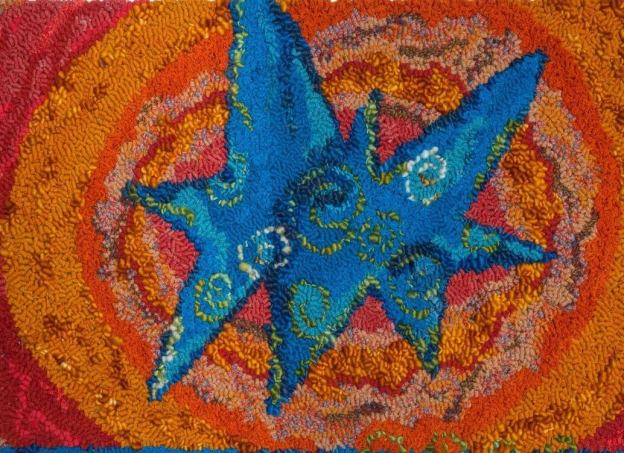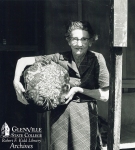
Jennifer Lockwood and Susan after hanging show
There is an arts community evolving at The River House in Capon Bridge, Hampshire County, WV. Monthly art exhibits feature one artist or a theme, September it is me! Meet and greet Friday Sept 1 4:30-5:30 followed by an open mic night. Fiber art is on display Thursday-Sundays through Sept 24 which is Capon Bridge’s Founder’s Day celebration also. Food, classes in art, music, craft, food, general living skills are conducted by members of the community. Come visit, we are one county into WV just west of Winchester, VA and 2 1/2 hours from Washington, DC on RT50W.
Track lights and a hanging system on white walls creates a gallery display for cafe goers and entertainment audiences as they listen/participate in staged shows.
I actually hung two shows, focusing on one theme for each display wall. What will catch the eye of visitors first I titled “Observing while traveling through…”

mixed textile pieces depicting nature
The natural wonder of West Virginia is affected by humans exploring, encroaching and expecting the resources to make them happy. Voices both vocally and visually are used to bring awareness to the fragile environment. The latter method to communicate is my preference, believing the image of even a tourist’s visit captured using traditional crafts will encourage awareness and protection for the future.I encourage you to view my art for the moment of beauty I captured and shared with you.
-

-
Enjoying the View
-

-
Haying Stages, Susan L. Feller
-

-
Observing as you travel through
-

-
Neighboring Barn
-

-
Neighbor’s Barn
-

-
5-11-14 Plowed Field-Year Study
-

-
10-18-14 Maple-Year Study
-

-
Leaf Peeping Season
-

-
Warm in Our Log Cabin
The opposite wall presents the Iconic Series created over fifteen years.

Liberty, ERA, Voting by Susan L Feller
The pieces chronicle three generations of women. My grandmother came of age in the 1920’s working and supporting herself prior to marriage. That marital relationship from the stories I heard and witnessed was one of equal responsibilities as entrepreneurs. Iconic Liberty and women’s right to vote in 1920 symbolizes her powerful self-esteem.
My mother again worked before marrying going back to work when we were in grammar school because she had administrative skills to share. Volunteering as a Girl Scout leader her encouragement and example kept me involved through high school. The early 1970’s environmental awareness and the quest for establishment of the Equal Rights Amendment are represented by Iconic ERA. (A line from each yellow badge set to the center forms the PEACE symbol.)
I was raised to question, research and vote for candidates and principles I believe will benefit the community, country and global elements. Iconic Rights captures the 2016 election with an important message: “I voted…and You?”
The circle in each design is an ancient symbol for life. I used it because our lives are part of a continuum. We all have contributed.
There are four small pillows with hooked fronts and embroidered backs bringing attention to contemporary issues: Gender, Climate, Rights, and Persisting. Generations of artists used traditional crafts to communicate: reflecting, documenting events, opinions and the spoken word.
-

-
Gender – Pussycats Pillow Talk Series
Perhaps it is my comfort with age, a realization that my voice is heard, or a confidence that others can be encouraged to think; whatever drives me the making of this body of work is cathartic.
It will be interesting to talk with visitors Friday and through the month sharing techniques, approaches to subject and issues raised by these visual objects. Except for the Iconic Series the works are for sale. There are also several images made into notecards. Can’t visit in person shop online at my store.






































































